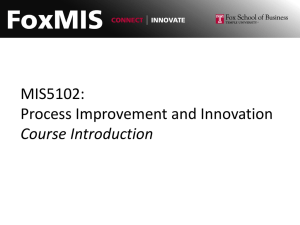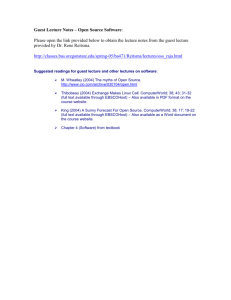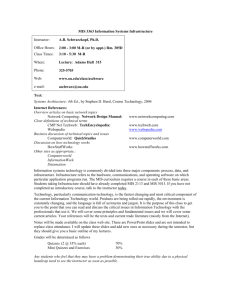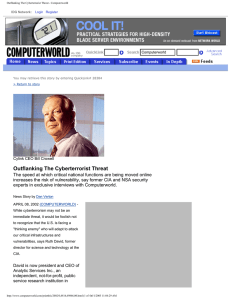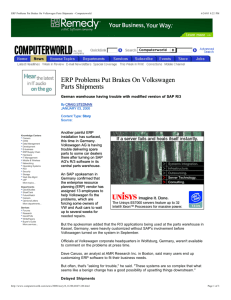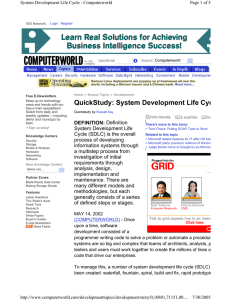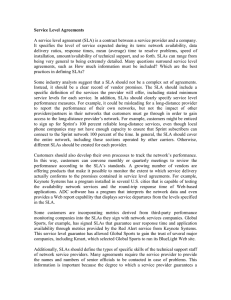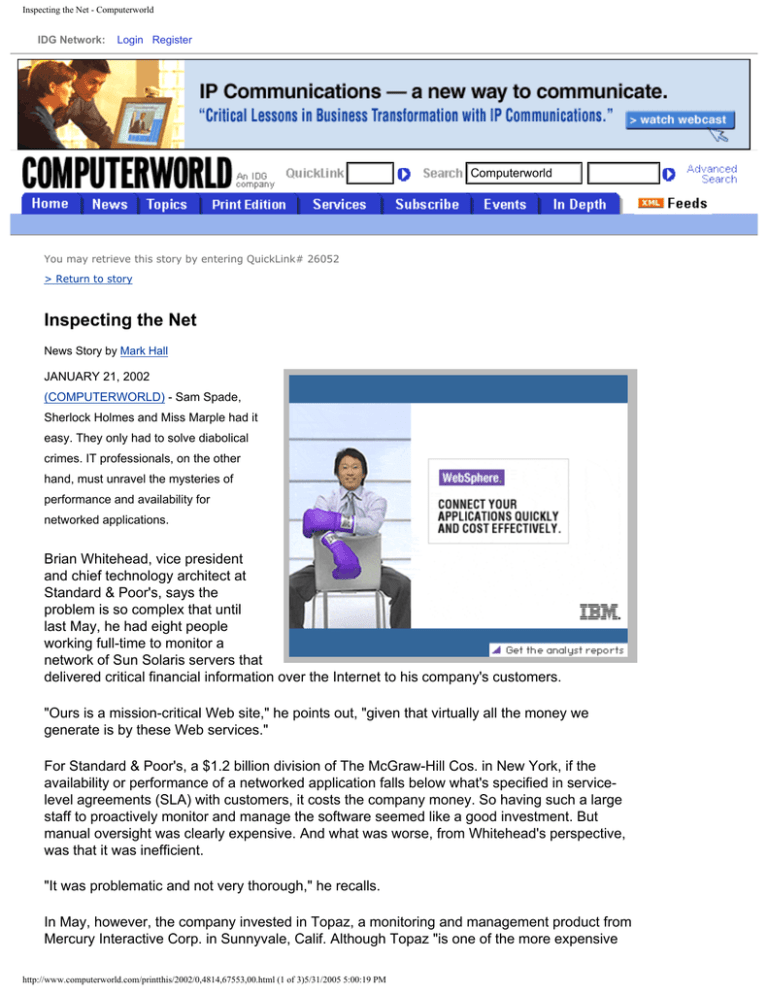
Inspecting the Net - Computerworld
IDG Network:
Login Register
Computerworld
You may retrieve this story by entering QuickLink# 26052
> Return to story
Inspecting the Net
News Story by Mark Hall
JANUARY 21, 2002
(COMPUTERWORLD) - Sam Spade,
Sherlock Holmes and Miss Marple had it
easy. They only had to solve diabolical
crimes. IT professionals, on the other
hand, must unravel the mysteries of
performance and availability for
networked applications.
Brian Whitehead, vice president
and chief technology architect at
Standard & Poor's, says the
problem is so complex that until
last May, he had eight people
working full-time to monitor a
network of Sun Solaris servers that
delivered critical financial information over the Internet to his company's customers.
"Ours is a mission-critical Web site," he points out, "given that virtually all the money we
generate is by these Web services."
For Standard & Poor's, a $1.2 billion division of The McGraw-Hill Cos. in New York, if the
availability or performance of a networked application falls below what's specified in servicelevel agreements (SLA) with customers, it costs the company money. So having such a large
staff to proactively monitor and manage the software seemed like a good investment. But
manual oversight was clearly expensive. And what was worse, from Whitehead's perspective,
was that it was inefficient.
"It was problematic and not very thorough," he recalls.
In May, however, the company invested in Topaz, a monitoring and management product from
Mercury Interactive Corp. in Sunnyvale, Calif. Although Topaz "is one of the more expensive
http://www.computerworld.com/printthis/2002/0,4814,67553,00.html (1 of 3)5/31/2005 5:00:19 PM
Inspecting the Net - Computerworld
solutions out there," given the importance of the applications it monitors, Whitehead says, it's
worth every penny.
Standard & Poor's has written 60 custom scripts - 40 in the first two weeks it had the product that observe everything from whether an application is available to the timeliness of the
information being delivered across the Web. For example, if Topaz discovers that a stock price
hasn't been updated recently, it alerts an editor that the content needs to be refreshed.
The software also stress-tests the application over the Internet. "It lets us impersonate our
customers by pounding on [Web] pages every minute," says Whitehead.
Imitating the User
For Joe Romello, CIO and vice president of engineering at Global Sports Inc. in King of
Prussia, Pa., mimicking user behavior does more than help him determine availability; it helps
him plan for network capacity and server workloads.
Global Sports runs the Web businesses for many brick-and-mortar firms, Romello says. For
example, it licenses San Francisco-based BlueLight.com LLC's name from Troy, Mich.-based
Kmart Corp. and not only runs BlueLight's Web site but also maintains a warehouse, delivers
products to shoppers and integrates its operations with store systems so customers can return
goods in person.
"Customers and even store employees can't tell that BlueLight.com is run by a separate
company," Romello says.
To earn that level of trust from Kmart and dozens of other companies, Global Sports signs
SLAs that guarantee application availability and user response time. And it uses agreed-upon
metrics provided by the Web Site Perspective network monitoring tool from Keynote Systems
Inc. in San Mateo, Calif.
Keynote has a program installed in 60 U.S. cities that tests the availability and round-trip
response time of Internet-based applications for its users. Global Sports subscribes to a
Keynote service that mimics user behavior via scripts that do everything from sending page
requests to ordering products.
Romello says Web Site Perspective's reports have been instrumental in maintaining SLA
requirements during crises. Once, when a fire in a Baltimore tunnel knocked out a major
Internet connection last year, Romello got enough of a warning to be able to reroute network
traffic farther west.
Equally important, he says, is that Web Site Perspective helps him plan load-balancing and
network capacity priorities. For example, Global Sports works closely with Kmart marketing
managers who often run regional promotions that create traffic spikes on BlueLight.com. With
the historical data Romello gets from Web Site Perspective, he's able to anticipate how much
extra server or communications capacity will be needed to handle the increased traffic.
"Web Site Perspective lets us watch the Internet weather," Romello says. "If AOL is backed
up, it's like Chicago affecting air traffic."
Verifiable Metrics
Rick Sturm, an analyst at Enterprise Management Associates Inc. in Boulder, Colo., and
http://www.computerworld.com/printthis/2002/0,4814,67553,00.html (2 of 3)5/31/2005 5:00:19 PM
Inspecting the Net - Computerworld
author of Foundations of Service Level Management (Sams Publishing, 2000), says it's
essential to build third-party metrics into an SLA with a service provider.
"Can you trust a service provider to honestly measure the service and support?" he asks. "In
some cases you can, in some not."
Sturm says many users are naive about SLAs and don't ask for independent verification of
metrics in a contract. But they should, he says.
Vericenter Inc., a managed service provider in Houston, incorporates metrics into its SLAs that
are derived from network and application monitoring and management tools from BMC
Software Inc., also in Houston. Dave Colesante, chief technology officer at Vericenter, says his
clients - primarily banking and oil firms in the region - agree to a set of performance and
availability measurements based on BMC's software.
Because BMC integrates information from its Internet-based tools, such as SiteAngel and
GuardianAngel, into Patrol, its enterprise management product, Vericenter is capable of
offering a three-tiered SLA, says Ron Pollvogt, the company's vice president of product
management. That way, users aren't restricted to a single level of service.
Naturally, he says, users pay more for higher-quality SLAs. But because Vericenter doesn't
"own" the user's application, the highest level of guarantee in the SLA is on availability.
Qwest Communications International Inc. in Denver is rolling out an aggressively tiered
approach to its business users, according to Martin Capurro, director of IP product
management. Qwest is using Keynote's technology to offer an SLA that guarantees
application performance levels and availability.
"This kind of SLA will give us a competitive advantage," says Capurro.
Products like Topaz, Red Alert and GuardianAngel all give users the ability to directly monitor
their SLAs. Because they're Web-based, they let users peer into the metrics of a network
application's performance and availability through a browser, even when used as a
subscription service.
This is an important component to add to any SLA, says Neil Goldman, an analyst at The
Yankee Group in Boston. "You want to know what your user is experiencing," he says.
Copyright © 2005 Computerworld Inc. All rights reserved. Reproduction in whole or in part in any form or medium without express written permission of
Computerworld Inc. is prohibited. Computerworld and Computerworld.com and the respective logos are trademarks of International Data Group Inc.
http://www.computerworld.com/printthis/2002/0,4814,67553,00.html (3 of 3)5/31/2005 5:00:19 PM

